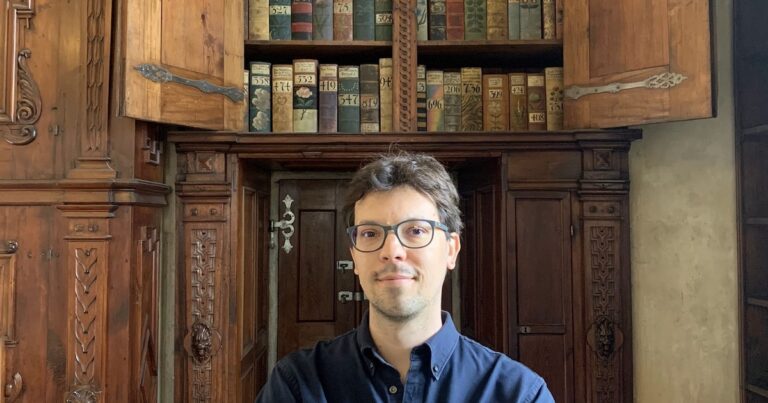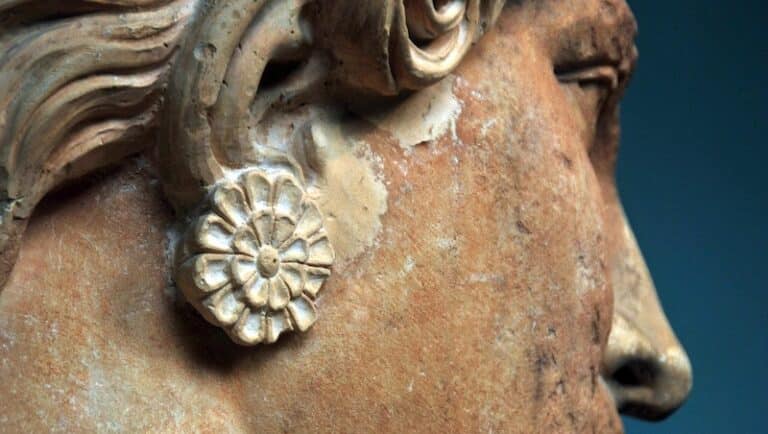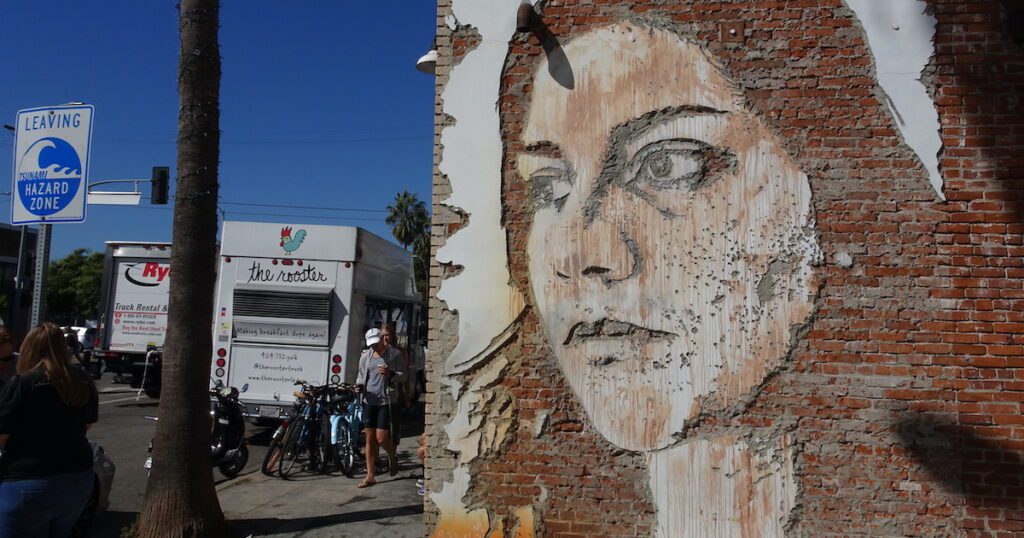Rootedness, migration, and translation in Cesare Pavese’s work: for our themed column on Pavese’s contemporary critique, Iuri Moscardi interviewed Federica Di Blasio.

You have recently published “Cesare Pavese, Homo Mediterraneus?” in Italian Culture. In that article you focused on some of the most important aspects associated with Pavese: rootedness, migration, and translation. How did you approach them and what perspective did you choose to analyze them?
I mentioned before that translation and migration were separate directions of research that I explored during the first years of my graduate education. It was a pleasure to see these two strings of inquiry come together in my research on Pavese. The idea for this article – and the whole research that led to it – came, more specifically, as I returned to Pavese after thinking about migration for some time. As many young Italians, I first learned about Pavese in school – certainly high school, and probably middle school. I remember being about 14 when I first read excerpts of La casa in collina. Then, two other memories come to mind. First, a warned copy of La luna e i falò that I saw circulating among avid readers in my high school, I must have been 16 or 17. Fast forward to my years as an undergraduate student at the University of Bologna. I am sitting with my friend Mirko in Piazza San Giovanni in Monte, and I feel what my students call “FOMO”: Mirko had taken this amazing course on Dialoghi con Leucò with Marco Antonio Bazzocchi, and I did not nor would have the chance to take the same course. I immediately started binge reading this book and everything about it, and that was the topic of many other conversations with Mirko. I am recalling these anecdotes to say that since an early age Pavese has been very present in my circles. At that point, though, Pavese was a familiar, soothing voice for me and not an object of critical inquiry. I had to take a break from Pavese before I could return to his work and look at it with a completely different gaze. The new perspective I had in re-approaching Pavese was to think trans-disciplinarily about the cultural challenges of contemporary Italy and specifically the resistance that Italian governments have shown against challenging a narrative of migration – both immigration and emigration – that is outdated, to say the least. I am thinking about the need to reform the citizenship law, which paradoxically facilitates a bond with descendants of emigrants – who, in some cases, have a very, very loose connection with Italy –, but complicates it for young Italians born of foreign parents, despite the fact that the latter call Italy and the Italian language their home. Pavese was not a (transnational) migrant, but his entire work is about humans’ connection with places, rootedness, and how mobility in its different forms (migrating, commuting) affects people. The need to leave, the need to stay, the need to return. All these “moods” or existential drives are very much present in Pavese’s works. As I re-read Pavese with this new lens, I imagined Italian students coming from experiences of diaspora, either direct or of their parents, reading Pavese for the first time. What would Pavese say to them? I am not in the position of answering this question, but I hope this starts a conversation on how the diversity of contemporary Italy and the need to decolonize Italian academic curricula change the experience of reading Pavese.
The starting point of your article is Carlo Bernari’s provocative suggestion that Pavese should be considered as a “Southern” writer. What does this mean?
“Is Pavese a Mediterranean writer?” was the hypothesis that I wanted to test in my analysis once I realized that his depictions of land, sea, and ocean could reveal something more than a simple aesthetic sensitivity to natural landscapes. Calvino made some remarks on how Pavese became slowly accustomed to the sea, while hating it during his confino in Calabria, but I wanted to revisit these conclusions. I thank Roberto Dainotto (member of my Ph.D. committee) for recommending Bernari’s essay “Ma esiste davvero una letteratura meridionale?,” which made me realize that my hypothesis was very much in tune with Bernari’s views. Writing in the 1980s, Bernari states that Pavese could in all respects be considered a “Southern” writer, if only one paid attention to the quality of his writing rather than the fact that he was born Piedmontese. Bernari’s intention was to shatter the simplifications that have often trapped writers from non-Northern regions of Italy into generic labels that don’t give justice to the plurality of points of views that each of these writers have contributed to the national literature.
In your article, you defined Pavese’s anti-oceanic attitude: for him, land and sea are two opposite mythical realms, and he chose the land as the only place for someone’s roots (a topic related to the return of many of his characters). How does this attitude might be mirrored in the contemporary opposition between local and global, as it was mirrored in the culture of ius sanguinis?
I have been careful in keeping my historical and philological references firm – and I want to restate this in case seeing Pavese and a citizenship law from 1992 in the same essay may seem anachronistic to some at first. Obviously, Pavese lived in his historical time, and this needs to be distanced from the the local/global dynamics we see at work now. I had in mind a Foucauldian, genealogical approach when noticing a sort of continuity between the geophilosopical framework I have identified in Pavese, and the cultural assumptions behind our current law on citizenship. In other words, there are cultural traces of “ius sanguinis” – which is a specific interpretation of individuals’ right to the land – in Pavese that we also see in our current citizenship law. Pavese lived most of his adult life during Fascism, and then there was also the war. The forms of belonging that we see represented in Pavese’s work are “vertical” and rigid, generating forms of exclusion that cannot be cured. The origin of Pavese’s exclusion is existential, but he gives it narrative forms that are also geopolitical, cultural, or even racial. Moreover, in Pavese there is this mythical depiction of Italians who migrate and eventually return. The insistence on the need to return, which we see in Pavese a lot, is also still implied in our citizenship law – if not the migrants themselves, their descendants will return. It is clear that Pavese was not thinking in legal terms, but geophilosophical and/or geopolitical understandings of what it means to live in a place and to belong to a place (and community) are strongly apparent in his works. As I was thinking about Pavese and migration in these terms, I have found two extremely interesting points. First, I could not believe that our current citizenship law would feel so close, in its cultural assumptions, to the work of a writer that died in 1950. In case we needed more evidence that this law is outdated, we have it there, right in front of us! Secondly, I was intrigued by the fact that Pavese, who is obsessed with rootedness, hills, and land, would also be the writer who gave us a pioneering translation of the “oceanic” novel Moby-Dick, which instead celebrates the absolute freedom that comes from living ashore. This was an apparent contradiction that I wanted to investigate. At UCLA I had carefully read Franco Cassano’s Il pensiero meridiano with my co-advisor Lucia Re. I borrowed Cassano’s geophilosophical terms of land, ocean, and sea to make sense of the relationship between these elements, on which both Bernari and Furio Jesi had also commented. I think that Pavese translated the oceanic novel Moby-Dick while still resisting its oceanic spirit. This might be the most “Mediterranean” quality of Pavese’s work: that he used myth to contrast land and sea as absolute realms, without ceding to the oceanic spirit that commands no return, no anchor. Pavese, in a certain way, “domesticated” Moby-Dick for the Italian reader.
The investigation of how the local/global tensions shaped the aesthetics of Pavese (together with Pasolini and Celati) was the main focus of your dissertation, too. How did this tension manifest and shape the aesthetic of Pavese?
The question of the tensions between the local and the global scales and how they operate culturally is a very complex, broad, and fascinating one that will hopefully occupy me for the next years. Summarizing this issue in terms that help us delve into Pavese’s aesthetics, I can at least say that the “local” and “global” are axes that shape how we see the world and how we see our action, identity, (access to) mobility in this world. Globalization has exacerbated this, but we need to keep in mind that world capitalism did not start in the 20th century – as Antonio Arrighi, among others, explains well. I have found worth re-studying Pavese for my dissertation because the tensions between the local and the global assume a unique form in his work, one that is hard to imagine exactly replicated elsewhere. There is definitely friction between Pavese’s fascination for the foreigner – specifically, American literature and cinema – and what I have called, for lack of better words, his ante litteram “anti-globalism.” The latter takes different forms. Pavese’s gaze was mostly turned towards the peripheries or provinces of the capitalized world. With care and curiosity, he described the rural societies that he saw changing and giving up to different urban and uprooted lifestyles. We know that Pavese was living during a time when migration worldwide was at its lowest records for that century; he was living in a country where racism was systemic, and colonization was happening outside the Italian frontiers (although there is almost no mention of this in his writings). I cannot separate Pavese from this context. At the same time though, Pavese’s geophilosophical views were extremely idiosyncratic. For example, Pavese thought that not even in their mind should a poet invade another person’s land. Pavese hated exoticism (which, we know, paired with European imperialism so well). There is a certain radicalism in Pavese’s geophilosophical vision. If one followed the logics of Pavese’s poetics, colonialism in any form should have never occurred.
You are now working at Hamilton College. As a young researcher and a junior scholar, what do you think are the most promising perspectives for future research on Pavese?
What I see promising now is to integrate Pavese’s work in courses and discussions on postcolonial Italy, migration, and citizenship. Pavese might not give the answers we are looking for to solve contingent problems of our present time, but he sets the tone to have meaningful conversations on these subjects. Secondly, there is a certain complexity of gender representation that is certainly worth studying. For example, I was teaching at the University of Georgia when Texas banned abortions beyond six weeks of pregnancy and passed other dangerous restrictions to women’s reproductive rights. Two days after the ban became effective, my students and I read about Silvia’s death caused by a clandestine abortion in La luna e i falò. The class was hard to teach, but Pavese’s words were as relevant and powerful as they could possibly be. This is another instance where I wish we could feel more distant from Pavese’s world.
“Un Pavese ci vuole”: this misquotation from a very famous passage from The Moon and The Bonfires was the title of a series of video-interviews I conducted with the director of Fondazione Pavese, Pierluigi Vaccaneo. Seventy-three years after Pavese’s suicide, do we still need him? And, whether yes or no, why?
I have not specifically addressed the issue of Pavese’s suicide in my research – I would turn to Elizabeth Leake’s book on this subject for inspiration. But to answer your question of “why Pavese now?” or “why Pavese, still?” I will say this: it is not by chance that all the references I made in this interview are followed by the names of the people with whom I have shared those readings, or who suggested those readings. First and foremost, literature is a relational matter to me. The power of literature is to make people feel connected and this is why we still need literature more than ever today. This is my personal way of dealing with the “life” and “art” dichotomy – if it makes even sense to speak of a dichotomy at all. I have genuine gratitude towards Cesare Pavese for the “poetry he gave to men” – I understand he meant “humans” there. I have felt deeply touched by it and at different times in my life. As a poet, novelist, and editor Pavese speaks of his time but he worked relentlessly towards a poetics that could also be his personal truth, a truth that he desperately wanted to share. I find this commitment admirable and inspiring as an intellectual, an educator, and a human being. While Pavese’s words stay the same, our questions as readers change based on what our experiences ask us to face and comprehend. To future researchers, I would say not to be afraid to ask Pavese the questions that most occupy their mind.
Cover image: a picture by Federica Di Blasio, shot near the ocean on Abbot Kinney Boulevard, Venice Beach, in 2017. In the picture, a work from the Scratching the Surface project through which Portoguese artist Vhils revisits the concept of roots, making portraits emerge from matter in overglobalised and ever-changing cities. The contrast between blue sky and red bricks recalls the contrast between elements the researcher is investigating in Pavese.

Dialogues with Pavese: Tommaso Munari
For our themed column on Pavese’s contemporary critique, Iuri Moscardi interviewed Tommaso Munari, author of a recent essay on the history of Italian publishing.

Dialogues with Pavese: Sara Vergari
For our themed column on Pavese’s contemporary critique, Iuri Moscardi interviewed Sara Vergari, author of the essay Un “Pavese solo”.

Dialogues with Pavese: Lawrence Smith
For our themed column on Pavese’s contemporary critique, Iuri Moscardi interviewed once again Lawrence Smith, this time about his English translation of Cesare Pavese’s degree thesis.



